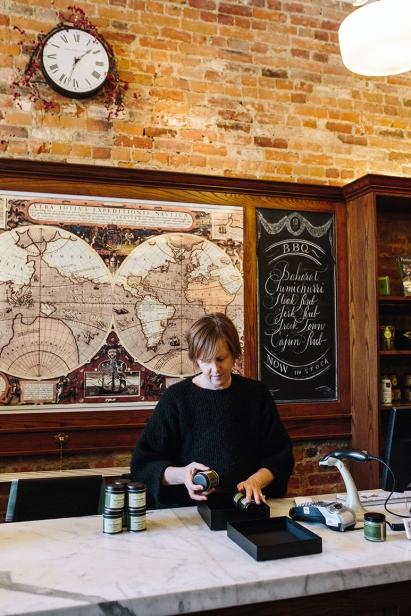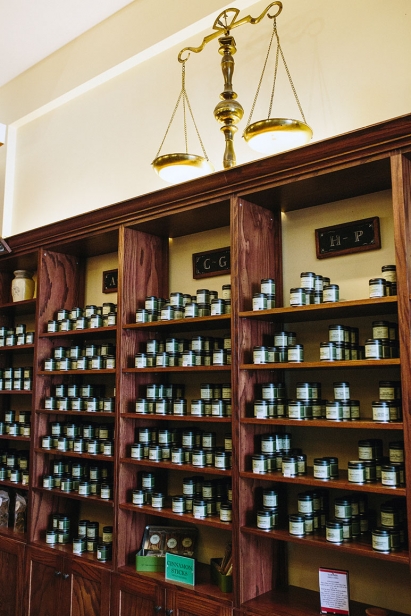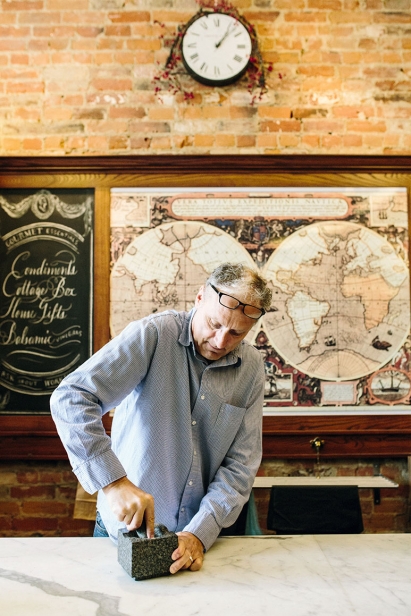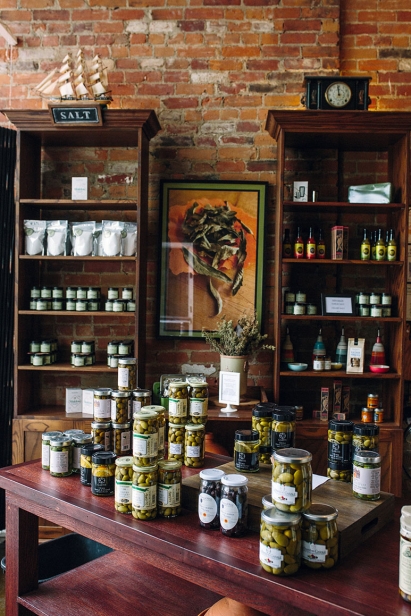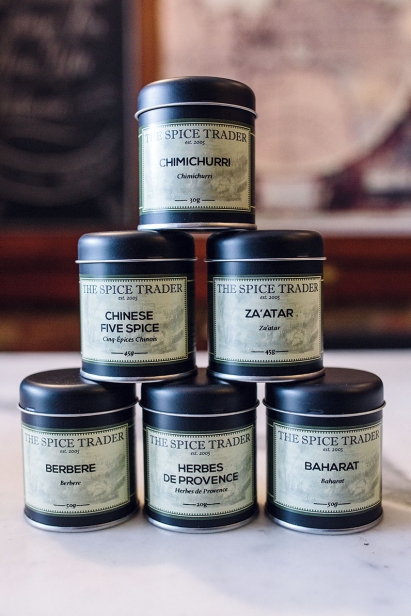The Spice Trader
Allison Johnston sells quality spices, oils and vinegars for a living, but as co-owner of The Spice Trader, she wears a number of hats.
Often, Johnston plays the detective. Her clients come to her with difficult questions and Johnston peels back the layers of their family story, right there in the shelves of her apothecary-like shop, which are stacked high with spices and herbs from around the world.
The Spice Trader, on Queen Street West, right across from Trinity Bellwoods Park, has been a go-to for cooks looking for fine quality, genuine spices, dried herbs, olive oils and vinegars since it opened in 2005, when there were no options beyond grocery store glass jars or traditional bulk stores.
“Once we opened our doors, people found us,” she says. “There was no one in Canada doing what we were doing in 2005.” The inspiration to open shop came after travelling through the Middle East and frequenting markets in Jerusalem and Istanbul, then in Europe, where she came upon spice stores in Rome and Paris. “Once we started the store, we concentrated more on bringing those spices to our customers, blending original mixes and educating our customers about cooking and flavour.”
It’s also where some people come looking for answers to family mysteries, particularly of the culinary kind.
“Cooking is so nostalgic for people,” says Johnston, who often helps customers identify a mystery spice lurking in an old family recipe. For instance, many culinary traditions use something called “allspice.” While it can often refer to Jamaica pimenta (commonly used in Caribbean cooking), it is a catch-all term in many languages and can mean very different things, depending on the origin of the recipe.
That’s where Johnston, spice sleuth, comes in. Investigating is a lot of fun, Johnston says. “We end up going through books and we’ll smell different spices.” She digs deep, asking customers what they remember smelling, seeing and tasting in their childhood kitchens. “It’ll be a recipe from a grandmother, mother, greatgrandmother... recipes that have been passed down. To remember that smell or that taste is very emotional for people. So it’s very fun when you’re able to find that thing for someone.”
Johnston is also a diligent researcher. When a customer on a family-recipe mission finds the mystery spice that will bring their grandmother’s cooking back, they also know it will be top of the line. She is uncompromising in the quality of her stock. “Air and light deteriorate spices,” she explains as the reason why the shop’s spices are sold in small quantities and in packaging that is air-tight and out of the light. All the shop’s spices are also free of added sugar, preservatives, fillers or MSG and are nongenetically modified.
Hunting down suppliers never stops. Because spices and herbs are agricultural products, their quality is variable from year to year and from region to region. This means spending a lot of time reading, chasing leads on the phone and making difficult decisions.
“We started with small producers that we searched out, some are directly in touch with farmers and some are larger distributors,” she explains. She’s been contacted by vanilla farmers in Uganda and NGOs dealing with small organic farms in Indonesia. “Some people we get one spice from, if we think it’s the best quality, and some we get many from.”
But if a particular product isn’t up to snuff, “then we’ll just have it out of stock. I’m not just going to bring something in [for the sake of having it.]” Every delivery is inspected by her husband and shop co-owner, Neil Bougourd, and “if it isn’t up to our standards, we return it.”
More obscure herbs and spices, such as ajwain seed (a southeast Asian spice similar to thyme) or grain of paradise (related to cardamom and native to West Africa), are certainly specialties at The Spice Trader, but the store’s reputation for quality also makes it a go-to for pantry staples. “Some of our best sellers are still thyme, oregano and rosemary,” Johnston says. She understands that sometimes it’s just convenient for customers to pick up common spices such as black pepper at the grocery story, but “inevitably, they come back.”
Of course, Johnston also loves to cook, meaning her own hands-on experience in the kitchen adds to her knowledge of the products she sells. She and Bougourd craft small-batch spice blends that become work-horses in customers’ kitchens. Chinese Five Spice (star anise, fennel, cinnamon, black pepper and cloves), Ras El Hanout (a Moroccan-inspired blend which includes cardamom, cumin, cloves, galangal and pink rose petal) and Za’atar (the Middle Eastern blend that combines dried sumac, sesame and thyme) are among their much-loved staple blends.
Johnston’s go-to, in her own kitchen, is herbes de Provence, which is a blend she makes. Johnston and Bougourd each have their own hand-blended specialty mixtures in the shop. When asked what she suggests making with the French-inspired mix, her answer is quick: “What wouldn’t you make with herbes de Provence?” The list of possibilities is endless, from roast chicken to soups, vinaigrettes to potatoes and fish.
Other blends can have surprising uses. Usually, shichimi togarashi, used in Japanese cooking, tops hot noodles, but Johnston has found a great place for it on popcorn.
The Spice Trader also offers classes and one of them is focused on making spice blends. Johnston teaches want-to-be spice experts what she has learned over the years. “There are amalgamating spices, like coriander seed, paprika or turmeric, which you could see as your base coat,” she explains. Painting with colours offers a good metaphor. “The amalgamating spices help bring out and blend the other spices. They’re like your gouache, and then you’re adding your accent colours.”
Johnston is a curator, too. That’s especially true during the holidays, when customers seek the perfect gift. The Spice Trader sells “spice collections,” a box of well-matched essentials for the burgeoning cook or someone wanting to experiment in a new food tradition. For example, the Indian Spice Collection or the Mexican Box, can serve as an introduction to new flavours.
There’s even an “Ottolenghi Box,” that pairs well with a cookbook from the famed British-Israeli chef Yotam Ottolenghi.
Finally, Johnston is a storyteller. As she recounts the origins and histories of the herbs and spices in her shop, she is effervescent. Each item in stock reminds her of an interesting customer or a particularly challenging sourcing problem.
She shows me Mexican oregano, which she points out is entirely different than the Mediterranean oregano used in Greek or Italian cooking. It reminds her of a young man who came into the shop once, eager to tell her about his passion: uncovering the Colonel’s very secret KFC chicken recipe. Johnston introduced him to Mexican oregano and he left the shop beaming, convinced he had discovered Sanders; long-kept secret.
All types of customers find their way into the shop. There have been witches looking for a certain rare ingredient for a mysterious project. There have also been fanatics of medieval cookery, who know they will find an obscure, ancient spice at The Spice Trader. Johnston loves talking to her customers, learning their stories and incorporating what she learns into her own story and that of her little shop.
The Spice Trader
877 Queen St. West., Toronto, Ont.
thespicetrader.ca | 647.430.7085 | @thespicetraderto
Tips from the spice trader, Allison Johnston
Favourite spice for holiday baking? Nutmeg — it's good for eggnog and Brussels sprouts. It's a baking and mulling spice.
Best spice for roasting chicken? Herbes de Provence Most undervalued spice? Bitters (mustard, tarragon, bay leaves) and sours (amchur, sumac)
Most overused spice? Salt — often when something is missing we just add salt, when we should use bitter, sour or sweet to help balance the dish.
Next spice to go mainstream? Black garlic
The spice you use the most? Berbere — our Ethiopian blend, used in traditional Doro Wat, but also with roasted chickpeas, soup and roasted vegetables.
Best spice to gift the non-cook? Aleppo pepper — a fruity chili pepper with medium heat, that is great on takeout pizza, a simple pasta with olive oil, popcorn or mixed in mayo for a dip with cut vegetables. This is a great gateway spice that adds flavour and not just a little heat.
Best spice to gift the cook who has everything? If you want to challenge them, give them Loomi or Brown Cardamom. If you want to excite them, give them saffron, smoked black pepper or white truffle salt. If you want to inspire them, give them the around the world box, which contains nine custom spice blends from around the world.
Most kid-friendly spice? Baharat — its heat is quite mild and is great for introducing flavour.



